A creativity in the balance between originality and conventionality.
 In Costa Brava, Portbou http://www.catalonia-valencia.com/portbou-travel-guide.html is a town with a special seafaring tradition. Its peculiar location turned this town into one of the main points of access into Spain. Its fishing port sits on a sunny coastal valley. Its historic quarter is surrounded by coastal hills and slopes covered with vegetation. Its coast washed by crystal waters, waiting for you with a splendid seabed for scuba diving and swimming. Playa de Portbou, its the main beach (around 270 metres long by 50 metres in width), is never too busy Even if the sea has erased its footprints on the sand, here you can perceive the creative atmospheres that inspired a Spanish painter.
In Costa Brava, Portbou http://www.catalonia-valencia.com/portbou-travel-guide.html is a town with a special seafaring tradition. Its peculiar location turned this town into one of the main points of access into Spain. Its fishing port sits on a sunny coastal valley. Its historic quarter is surrounded by coastal hills and slopes covered with vegetation. Its coast washed by crystal waters, waiting for you with a splendid seabed for scuba diving and swimming. Playa de Portbou, its the main beach (around 270 metres long by 50 metres in width), is never too busy Even if the sea has erased its footprints on the sand, here you can perceive the creative atmospheres that inspired a Spanish painter.
Born in Portbou (near the French border), ANGELES SANTOS TORROELLA was the eldest of eight children, into a family that led a poor life. In 1924 she was sent to a convent in Seville, where a mother superior she urged to foster her painting skills. Observing her paintings, isnt hard to grasp the split in her art, between the originality of her adolescent masterpieces and the conventional painting of the rest of her life. In 1933, she settled in Barcelona, where married the painter Emili Grau. When the civil war erupted, the couple left Spain for France. In 1937, she returned to live with her parents in Canfranc (in the Pyrenees), where she gave birth to a child. Back in Barcelona she was painting again, but under the influence of a bland impressionist style.
She was often referred to as a Spanish Rimbaud. By the age of 19 she had completed her best work, but unlike Rimbaud she later took up her art again in a different style. Well-known intellectuals visited her home in the city of Valladolid (among them the poet Lorca). In 1929 her painting “A World” became the sensation of the IXth autumn salon in Madrid. In 1931 ANGELES SANTOS TORROELLA had a solo exhibition in Paris, but nervous breakdown she had already stopped painting, spending weeks in a sanatorium and destroing many of her paintings. In her last years, she lived in Madrid with her son (the painter Julián Grau Santos). You can find her works at the Reina Sofía National Art Center Museum (Madrid) in the Ampurdán Museum (Figueras).
The intellectual property of the images that appear in this blog correspond to their authors. The sole purpose of this site, is to spread the knowledge of these artists and that other people enjoy their works. To pursue this issue, you can digit: https://www.youtube.com/watch?v=rTChvaPfB6w
Audio Player Meeting Benches World art in all forms
Meeting Benches World art in all forms





































